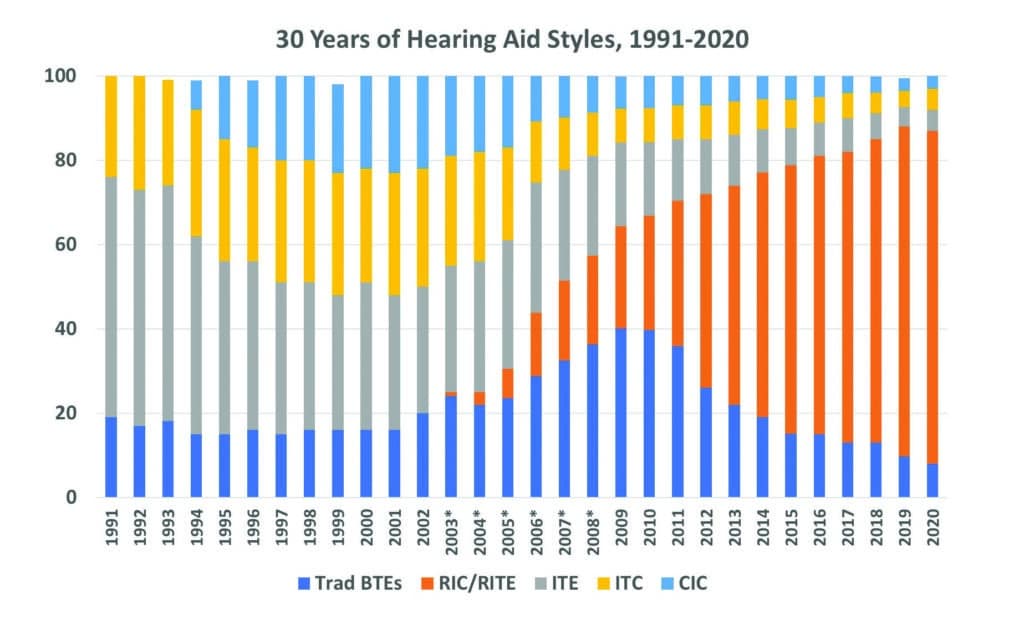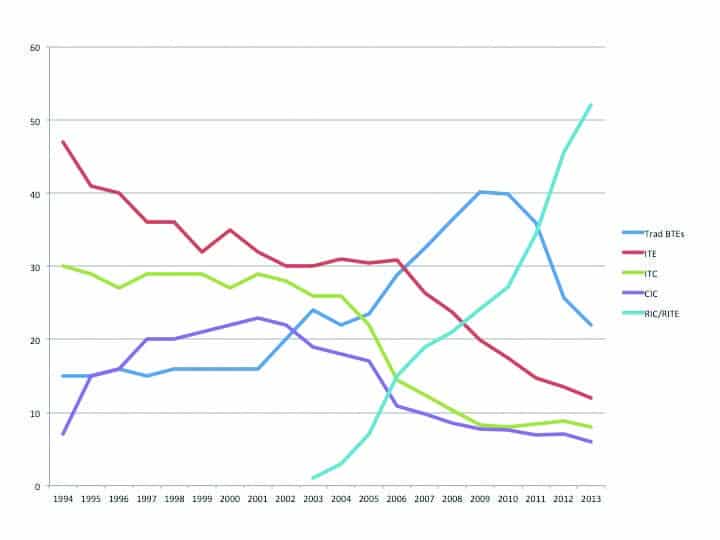Staff Standpoint | July 2021 Hearing Review
By Karl E. Strom
Last month, this column explored the different circuit technology types (1979-2020), ranging from analog linear circuits of the 1980s, to the automatic signal processing (ASP) and digitally programmable technologies of the 1990s, and finally the DSP and wireless technologies of the 21st Century. This month we’ll look at US hearing aid style preferences and selection trends, as reported in Hearing Industries Association (HIA) historical statistics, along with estimates by The Hearing Review.
Figure 1 shows the evolution of hearing aid styles during the last 30 years, from 1991 to the present. Immediately clear is the dominance of in-the-ear (ITE), in-the-canal (ITC), and completely-in-the-canal (CIC) hearing aid styles until the mid-2000s. Custom (and some stock model) ITE and ITC hearing aids constituted 81% of the US hearing aid market in 1991, with traditional behind-the-ear (BTE) hearing aids making up the rest (19%).

The miniaturization of circuitry and zinc-air batteries led to the introduction of CICs in the mid-1990s—a favorite style of consumers seeking the most “invisible” hearing aid solutions. CICs quickly grew from about 7% of the market in 1994 to 23% in 2001. By 1996, when the first digital signal processing (DSP) hearing aids were introduced by Oticon and Widex, about 6 of 7 (83%) hearing aids dispensed in the United States were ITEs, with half- and full-shell ITEs constituting 40% of the market, ITCs 27%, and CICs 16%. These numbers stayed relatively static through 2002, with CICs and ITCs continuing to gain some steam.
Although directional microphone (DM) technology had existed well before the turn of the century, the introduction of more advanced systems within BTEs featuring both omnidirectional and directional capabilities (eg, the Phonak AudioZoom BTE in 1994) demonstrated the utility of DMs for improving speech understanding in noise and overall customer satisfaction. The venerable BTE was also the main—and often only—option for people with more severe hearing losses requiring greater gain and larger battery sizes.
A sea-change occurred in the early 2000s with the introduction of the ReSound Avance slim-tube, open-fit BTE, the SeboTek PAC (a closed-fitting RIC device), and later, the Vivatone open-fit RIC/RITE—all early examples of the impending RIC/open-fit revolution. (Note: As with DMs, several open-fit BTEs had been introduced earlier, but had limitations in feedback control due to the analog circuit technology. For example, Oticon introduced the E43 mini-BTE in 1989 and the Personic 430 open-fit BTE in 1992.) In mid-2003, GN launched the ReSound Air open-fit digital BTE which became a huge commercial success, followed by many premiere hearing aid introductions that incorporated open-fit RIC styles.
As pointed out in the June 2014 HR article, “The RIC as a Disruptive Technology,” thin-tube BTE and RIC technology dramatically changed the selection process in hearing aid fitting, with RICs eventually dominating the market just over 10 years after being introduced (Figure 2). At the same time, “traditional receiver” BTE fittings also grew in market share, starting in 2002, probably due to their enhanced DM capabilities along with the cosmetically pleasing slim-tubes. By 2013, traditional BTEs and RIC/RITEs made up 74% of the US hearing aid market when adding together. By 2020, BTEs made up 87% of the market, with RICs constituting 79% of all US hearing aids sold and traditional-receiver BTEs constituting 8%. The remaining 13% was made up of ITEs (5% half- and full-shell ITEs; 5% ITCs; 3% CICs).

What’s the Future for Hearing Aid Styles?
Will RICs continue to dominate the selection and fitting process in the United States? Currently, there are no signs of them losing out to other styles. However, with future pressure from over-the-counter (OTC) RIC-type devices, custom ITEs could gain in popularity as dispensing professionals seek to differentiate their product offerings. This trend could also be spurred on by 3D ear scanning systems (eg, Lantos and Natus systems) for use in both ITEs and RIC custom molds.
Hearing healthcare may also be entering an era that emphasizes greater choice in terms of both styles and technology levels. Even earbud-type hearing aids could conceivably make some headway for people with mild losses. With new products catering to mild-loss or near-normal hearing levels, teleaudiology, and flexible pricing options, it seems likely that hearing aid styles will continue to evolve.
Citation for this article: Strom KE. Trends in hearing aid styles. Hearing Review. 2021;28(7):6,31.







RIC may appear to dominate influenced by some manufactures pressure to dispense RICs over slim tube fittings.